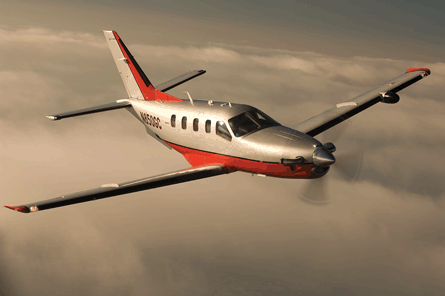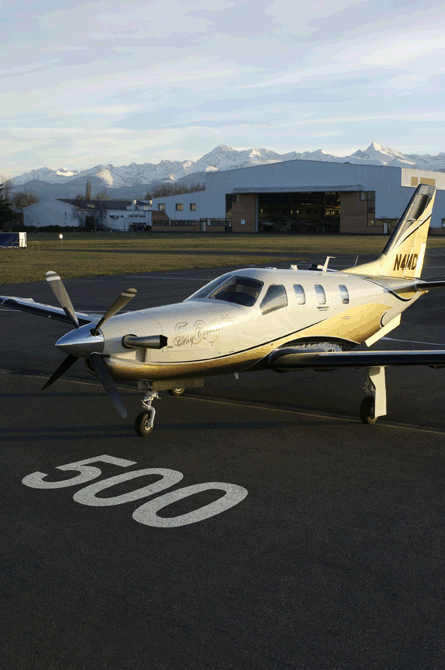For Socata, Daher's decision to take a majority stake in the company could scarcely have been better timed. News of the deal broke at the end of June 2008, just three months before the global banking system collapsed, sending business aviation into a tailspin.
The transfer of a 70% Socata stake from EADS to fellow French industrial group Daher was formally completed at the beginning of this year, and Daher's aerospace activities have since been organised into a division named Daher-Socata, of which Socata represents the airplane subdivision. Socata manufactures the TBM range of single-engined turboprops at its base in Tarbes, a south-western French town nestled amid perennially snow-capped Pyrenees mountains.
In its previous incarnation, Socata contributed "less than 1% of EADS's turnover", recalls Nicolas Chabbert, senior vice-president of Daher-Socata's airplane division. "At less than 1%, it is impossible to be watched correctly or understood," he says. "TBM is 15% of Daher's activity. Socata is representing 25% of the entire group. The attention level has been changed with this move." Yet EADS remains a 30% partner in Socata, which continues to collaborate with other companies in the group, adds Chabbert.
 |
|---|
© Daher-Socata |
The new majority owner, Daher, has certainly felt the sting of the crisis in business aviation. The company confirms that "roughly 50%" of scheduled Socata deliveries for the year so far have been deferred.
Some comfort can be drawn from the fact that business is falling from its highest peak on record: in 2008, Socata delivered a record 60 of its latest aircraft type, the seven-seat TBM 850 launched in 2006. European deliveries accounted for a 20% share, reflecting a broad trend in Socata's business. Where in the past the USA accounted for more than 90% of Socata's business, its share is now closer to 70%. Europe has meanwhile grown its portion, while business has also been won in Australia, Brazil and South Africa.
As of April 2009, 156 TBM 850s had been delivered, "almost half" of them equipped with the Garmin G1000 glass cockpit, intended to reduce pilot workload and ease maintenance. The first G1000-equipped TBM 850 was rolled out in January 2008. Serial number 508 will be on display at EBACE.
Named for its horsepower (850shp), the TBM 850 has a maximum cruise speed of 320kt (590km/h) at 26,000ft (7,930m) and a range of just over 2,600km (1,400nm). It represents an upgrade of the TBM 700, of which 323 were delivered following certification in 1990. The TBM 700 was developed with Mooney Aircraft as a 30% partner, but the Texan company withdrew from the programme around the time of the first delivery.
These are just the recent iterations in a history that stretches back almost a century. Only slightly younger than Flight International, Socata grew out of Morane-Saulnier, a manufacturer founded in 1911. During the Second World War occupation of France, Germany's Focke-Wulf 190 was produced at Morane-Saulnier's plant at Tarbes, until the Allies bombed it in 1944. In 1945 Morane-Saulnier unveiled the MS 470 two-seat trainer, which it had been developing in secret. The company gained the name Socata when it became a division of Sud Aviation in 1966, and it later merged into Aerospatiale and then EADS. Over the full course of its history it has built more than 17,000 aircraft.
 |
|---|
© Daher-Socata |
Today, a burgeoning aerostructures business runs alongside the aircraft manufacturing operation at Tarbes. With capabilities ranging from traditional craft skills and hand finishing to advanced composite technologies, Socata manufactures aerostructures for a diverse range of programmes: nose lower structures and composite landing gear doors for the Airbus A380, composite fairing sponsons and nose landing gear doors for the A400M, belly fairings for the A330/A340, engine pylons for the A320, upper fuselages for the Dassault Falcon 7X, body fairings for the Falcon 7X and 2000, rear sections for the Embraer 170/190, and airframes for the Eurocopter EC130 and EC350. It has also been confirmed as a tier-one partner in the A350 programme, for which it will provide the main landing gear doors.
WHAT NEXT?
In spite of the doom and gloom plaguing business aviation in 2009, Socata-Daher has not abandoned plans to add a 10-seat, twin-engined aircraft to its product range. The new twin, code-named the NTx, could be formally launched in 2010. However, investment partners must first be found, as Daher is prepared to fund only one-third of the programme's €250 million ($324 million) cost, says the company, which also confirms that the prospective new twin has already been pitched to the French military.
An internal review of the business plan for the new aircraft is under way at Socata. "We are at the stage of reviewing the technical solutions," says Chabbert. "We have a good feel for the marketing challenge."
Investment in the new twin is part of a two-phase investment programme in progress at Daher Group. In the first phase, €250 million of internally generated Daher funds were allocated to acquiring the Socata stake, opening new plants in Australia and Mexico, and financing non-recurring costs arising from A350 programme involvement. The second phase will bring investment of €300 million across the nuclear, aerospace and defence sectors. This will be part-funded by an €80 million capital increase, to which French state investment fund FSI subscribed, gaining a 17% stake.
In the meantime, Socata has maintained a consistent sales strategy focused on pilot-owner customers, despite the downturn. "The basics, for that type of customer, are to be excellent in customer service - that's what we are committed to," says Chabbert. "That doesn't change much, whether it's an economic downturn or economic growth."
Socata has, however, taken the step to introduce a new co-ownership programme, which is intended to reduce the capital outlay for a $3 million TBM 850 for potential owners who do not have sufficient capital to acquire an aircraft outright or cannot raise enough finance. Developed in collaboration with distributors, the "Fly and Share Your TBM" (Fast) programme can accommodate up to three shareholders per aircraft, with each gaining a minimum 100 days of exclusive use per annum on an unlimited flight hour basis.
 |
|---|
© Daher-Socata |
"We try to present the product in a new light for people who may not have thought that this was an available option," says Chabbert, who adds that some of the interest initiated by the Fast programme has led to sales on a full-ownership basis.
Additionally, Socata's drive to grow TBM 850 sales has targeted the burgeoning surveillance market. Efforts in this area will be stepped up during the Paris air show in June. "We have a strategy developed that is going to have a high point at Le Bourget, where we will have a multi-mission aircraft...equipped with a solution for surveillance," says Chabbert. "This is a strategy which we started about two and a half years ago. It takes a long time to get set up."
The TBM's core constituency - conceived as executives deploying aircraft as a business tool - is expected to expand, as corporate belt-tightening forces a move to smaller models, but Chabbert cautions that the pace of change could be slow. "You don't change overnight things that take months or years to establish...but we see the trend. There is a trend of not being seen as the 'jet buyer' or 'jet user'."
By Chabbert's reckoning, general aviation plays an essential role in filling out the transport network, filling gaps in the airlines' coverage. He is dismissive of the notion that general aviation is a luxury, citing its role in business travel, medevac and transport of small goods. "I'm not a defender of excessive use," he insists. "When I use a TBM I calculate if it's worth doing it... When you are putting it [forward] as a business tool, you have to think: is it efficient? Is it justifiable? Is it something you can afford?"
On the subject of affordability, he makes the point that many of Socata's target owner-pilot customers are heavily invested in the stock market and greatly expanded their wealth during the boom times. "Yes, the stock is down, but they made a fortune!" he says, arguing that the years of growth more than offset more recent declines. In this context, the barrier to new sales is "psychological", in Chabbert's view.
Another barrier to growth arises from an ongoing regulatory issue: European rules forbid the operation of single-engined turboprops in commercial public transport. An option to sell tickets might not in itself be enough to justify a purchase, but would be "plenty enough to offset some of the cost and therefore create more traction for this aircraft", says Chabbert. "Cessna [manufacturer of the single-engined Caravan range] and ourselves are united in a joint front to present single-engine data to the European Union. EASA said that there is a timeframe that they will study the file, but I think that expediting this would certainly help the European market."
A resolution would "incentivise drastically the single-engine turboprops market", he adds. "Many companies - in Bulgaria, in Germany, in the UK - if they didn't have the TBM they couldn't conduct their business. That could be increased with regulation that could help people go more for co-ownership."
Source: Flight Daily News























